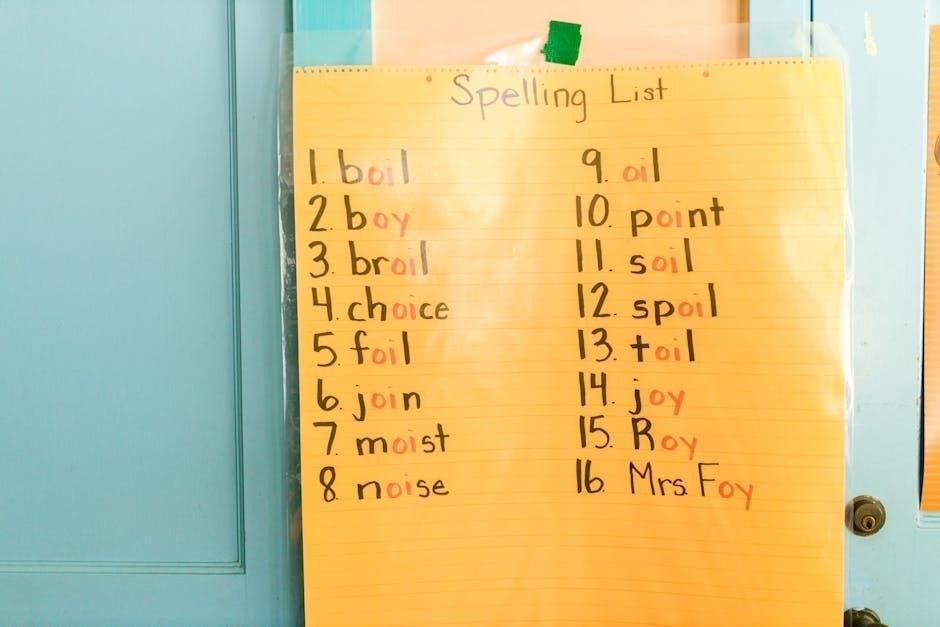R-controlled vowels are sounds where a vowel is followed by an “r,” changing the vowel’s pronunciation. They include “ar,” “er,” “ir,” “or,” and “ur.” These patterns are essential for reading and spelling, often appearing in common English words. A word list PDF can help learners practice and reinforce these sounds effectively, making them easier to recognize and use in daily reading and writing activities.
1.1 Definition and Importance
R-controlled vowels are vowel sounds in English where a vowel is followed by the letter “r,” altering its pronunciation. These sounds are crucial for reading and spelling accuracy. Common patterns include “ar,” “er,” “ir,” “or,” and “ur,” each producing distinct sounds. Mastering these patterns is essential for decoding unfamiliar words and improving literacy skills. A word list PDF is a valuable resource for practicing and reinforcing these sounds, helping learners recognize and reproduce them consistently. By focusing on R-controlled vowels, educators and learners can build a strong foundation for reading and spelling, making it easier to tackle more complex language skills.
1.2 Common Patterns in R-Controlled Vowels
The common patterns in R-controlled vowels include “ar,” “er,” “ir,” “or,” and “ur.” Each pattern produces a distinct sound, aiding in accurate pronunciation and spelling. The “ar” sound, as in “car,” the “er” sound in “her,” the “ir” sound in “bird,” the “or” sound in “door,” and the “ur” sound in “fur,” are essential for decoding words. Recognizing these patterns enhances reading fluency and spelling accuracy, making them fundamental for literacy development. Incorporating these patterns into a word list PDF provides structured practice, helping learners master R-controlled vowels effectively and confidently.
Understanding R-Controlled Vowel Sounds

R-controlled vowels produce distinct sounds when a vowel is followed by “r.” These sounds, like “ar,” “er,” “ir,” “or,” and “ur,” are crucial for accurate pronunciation and spelling, aiding in literacy development and effective communication.
2.1 The “ar” Sound
The “ar” sound is one of the most common R-controlled vowel patterns in English. It is pronounced with a short “a” sound followed by “r,” creating a distinct phoneme. Words like car, far, and star exemplify this sound. The “ar” pattern often appears at the end of words but can also occur in the middle, as in dark or market. This sound is consistent, making it easier for learners to recognize and spell once mastered. Including “ar” words in a word list PDF helps reinforce this pattern, aiding in reading fluency and spelling accuracy for students of all ages.
2.2 The “er” Sound
The “er” sound is a common R-controlled vowel pattern in English, where the “e” is followed by an “r,” producing a distinct phoneme. Words like her, teacher, and paper illustrate this sound. The “er” sound can appear at the end or within words, such as in runner or better. This sound is consistent, making it easier for learners to recognize and spell once mastered. Including “er” words in a word list PDF helps reinforce this pattern, aiding in reading fluency and spelling accuracy. Mastering the “er” sound is essential for improving overall language proficiency and confidence in reading and writing.
2.3 The “ir” Sound
The “ir” sound is an R-controlled vowel sound where the “i” is followed by an “r,” producing a distinct phoneme. Words like bird, girl, and third exemplify this sound. The “ir” sound is consistent in most cases, making it easier for learners to recognize and spell once familiar. Including “ir” words in a word list PDF can help reinforce this pattern, aiding in reading fluency and spelling accuracy. Regular practice with these words can significantly improve language skills. Mastering the “ir” sound is a valuable step in enhancing overall reading and writing abilities, providing learners with more confidence in their language use.
2.4 The “or” Sound
The “or” sound is a common R-controlled vowel pattern where the “o” is followed by an “r,” creating a distinct phoneme. Words like for, door, and more demonstrate this sound. The “or” sound is consistent in most cases, making it easier for learners to recognize and spell once familiar. Including “or” words in a word list PDF can help reinforce this pattern, aiding in reading fluency and spelling accuracy. Regular practice with these words can significantly improve language skills. Mastering the “or” sound is a valuable step in enhancing overall reading and writing abilities, providing learners with more confidence in their language use.
2.5 The “ur” Sound
The “ur” sound is another R-controlled vowel pattern, where the “u” is followed by an “r,” producing a unique phoneme. Words like fur, her, and cur exemplify this sound. The “ur” sound is consistent in most cases, making it easier for learners to recognize and spell once familiar. Including “ur” words in a word list PDF can help reinforce this pattern, aiding in reading fluency and spelling accuracy. Regular practice with these words can significantly improve language skills. Mastering the “ur” sound is a valuable step in enhancing overall reading and writing abilities, providing learners with more confidence in their language use.

R-Controlled Vowel Word List
A word list for R-controlled vowels organizes words by patterns like “ar,” “er,” “ir,” “or,” and “ur.” It includes examples such as car, her, bird, door, and fur, aiding in recognition and practice. This list helps learners master these sounds, improving reading and spelling skills effectively.
3.1 Common Words with “ar”
Words with the “ar” pattern are common in English, producing a distinct vowel sound. Examples include car, far, star, jar, bar, scar, par, mar, and tar. These words often relate to objects, places, or actions, making them practical for everyday use. The “ar” sound is consistent, helping learners recognize and spell these words confidently. Including these in a word list PDF can enhance reading fluency and spelling accuracy, especially for early learners. Organizing them by themes, like animals or objects, can further aid in memorization and application in sentences.
3.2 Common Words with “er”
Words with the “er” pattern are abundant in English, representing a distinct vowel sound. Examples include her, teacher, paper, water, mother, father, brother, sister, weather, and together. The “er” sound is consistent, making it easier for learners to recognize and spell these words. Including these in a word list PDF helps reinforce the pattern, improving reading fluency and spelling accuracy. Organizing them by themes, such as family members or everyday objects, can enhance memorization and practical application in sentences. This focused practice supports learners in mastering the “er” sound effectively.
3.3 Common Words with “ir”
Words with the “ir” pattern produce a distinct vowel sound, essential for accurate reading and spelling. Common examples include bird, girl, third, first, twirl, whirl, skirt, shirt, stir, and curtain. These words often appear in everyday language, making them crucial for learners to master. Including them in a word list PDF helps reinforce the “ir” sound, improving reading fluency and spelling confidence. Organizing these words by category or theme, such as animals or actions, can enhance learning and retention. Regular practice with these words supports learners in recognizing and using the “ir” pattern effectively in various contexts.
3.4 Common Words with “or”
Words with the “or” pattern are fundamental in English, producing a distinct vowel sound. Common examples include door, floor, before, more, store, score, shore, roar, soar, and explore. These words frequently appear in daily language, making them vital for learners to recognize and spell correctly. Incorporating them into a word list PDF can enhance reading fluency and spelling accuracy. Organizing these words by themes, such as places or actions, can further aid in memorization. Regular practice with “or” words helps learners master this pattern, improving their overall reading and writing skills in various educational and real-world contexts.
3.5 Common Words with “ur”
The “ur” sound is another key R-controlled vowel pattern, often producing a distinct pronunciation. Common words include fur, furrier, curl, whirl, twirl, hurl, pearl, and surf. These words are essential for building reading and spelling skills. Including them in a word list PDF helps learners recognize and reproduce the “ur” sound accurately. Grouping these words by themes, such as animals or actions, can enhance memorization. Regular practice with “ur” words supports fluency and confidence in reading and writing. These words are frequently used in everyday language, making them vital for mastering English pronunciation and spelling patterns.

Creating an R-Controlled Vowels Word List PDF
Compiling R-controlled vowels into a PDF enhances learning by organizing words into clear categories, making them easy to study and reference for effective practice and mastery.
4.1 Steps to Compile the List

To create an R-controlled vowels word list PDF, start by categorizing words based on their vowel-r combinations (“ar,” “er,” “ir,” “or,” “ur”). Include high-frequency words and examples from various grade levels. Use clear headings for each category and provide definitions or pronunciations if needed. Add images or diagrams to enhance visual learning. Format the list with readable fonts and bullet points for clarity. Proofread for accuracy and ensure the PDF is searchable for easy navigation. Finally, save and share the document in a widely accessible format, such as PDF, for educators, students, or parents to use as a study resource.

4.2 Designing the PDF for Clarity
Designing an R-controlled vowels word list PDF for clarity involves a clean layout and readable fonts. Use bullet points or numbered lists to organize words by category (“ar,” “er,” etc.). Add images or icons to visually reinforce each sound. Ensure consistent formatting, with bold or italic text for headings. Leave ample white space to avoid overcrowding. Include a table of contents or index for easy navigation. Highlight key sounds or patterns to draw attention. Use color coding for different vowel-r combinations to enhance differentiation. Ensure the PDF is searchable and hyperlinked for quick access to specific sections. This design approach promotes effective learning and easy reference.
Activities for Practicing R-Controlled Vowels
Engage learners with interactive games, worksheets, and reading exercises. Use flashcards, word searches, and sorting activities to reinforce R-controlled vowel patterns. Incorporate audio clips for pronunciation practice.
5.1 Interactive Games
Interactive games are an engaging way to practice R-controlled vowels. Use online platforms or apps featuring vowel sound matching, bingo, or sorting activities. Create digital flashcards with audio clips for pronunciation practice. Incorporate word-building games where learners arrange letters to form R-controlled vowel words. Quizzes and timed challenges can enhance retention and speed. Classroom games like “Vowel Sound Charades” or “Scavenger Hunts” encourage active participation. These activities make learning fun and reinforce the connection between sounds and spellings, helping learners master R-controlled vowels effectively. They can be adapted for different skill levels and used in both classroom and home settings.
5.2 Worksheets and Exercises
Worksheets and exercises are essential tools for practicing R-controlled vowels. They provide structured activities to reinforce learning and improve recognition of vowel sounds. Include fill-in-the-blank exercises, word matching games, and sentence completion tasks. Create word sorting activities where learners categorize words by their R-controlled vowel patterns. Offer word-building exercises using magnetic letters or digital tools. Reading comprehension passages with R-controlled vowel words can also be included. These resources help learners apply their knowledge in practical ways, improving both spelling and reading skills. Use visual aids and audio clips to enhance engagement and understanding, making practice both effective and enjoyable for learners of all ages.

Assessing Mastery of R-Controlled Vowels
Assessing mastery involves evaluating learners’ ability to read and spell words with R-controlled vowels accurately. Use quizzes, reading exercises, and spelling tests to track progress. Incorporate the word list PDF to create targeted assessments, ensuring learners can identify and apply R-controlled vowel patterns correctly in various contexts. Regular feedback helps refine their skills and address any challenges promptly.
6.1 Informal Assessments
Informal assessments are crucial for monitoring progress in mastering R-controlled vowels. Teachers can use oral reading exercises, where students read aloud from the word list PDF, to identify pronunciation accuracy. Observation during group activities or independent practice provides insights into comprehension and application. Quick quizzes or flashcard games using the PDF can gauge retention and fluency. Feedback during these assessments helps learners understand their strengths and areas needing improvement. Incorporating these methods ensures a supportive and adaptive learning environment, allowing educators to adjust instruction based on individual and group needs. Regular informal checks also build confidence and reinforce R-controlled vowel patterns effectively.

6.2 Formal Assessments
Formal assessments provide a structured way to evaluate mastery of R-controlled vowels. Standardized tests or end-of-unit exams can include sections dedicated to these sounds, using words from the PDF list. Spelling tests with R-controlled vowel patterns help measure retention. Reading comprehension passages containing these words assess application in context. Multiple-choice questions or fill-in-the-blank exercises can also be used. These assessments allow educators to track progress systematically and identify areas where additional support may be needed. By incorporating the word list PDF into formal evaluations, teachers can ensure a comprehensive understanding of R-controlled vowels and their correct usage in various contexts.
Teaching Tips for Educators
Use explicit phonics instruction to introduce R-controlled vowels, emphasizing patterns like “ar” and “er.” Incorporate visual aids and the word list PDF for targeted practice and reinforcement.
7.1 Explicit Instruction Strategies
Explicit instruction is crucial for teaching R-controlled vowels. Start by modeling the sounds and patterns, using the word list PDF to highlight examples like “ar” in car and “er” in her. Break down words into phonemes, emphasizing the vowel-r combination. Use visual aids to reinforce patterns and provide guided practice with worksheets or interactive games. Gradually release responsibility to students, allowing them to apply their knowledge independently. Regular review and feedback ensure mastery, making the word list PDF a valuable resource for targeted practice and reinforcement.
7.2 Differentiated Instruction
Differentiated instruction tailors teaching to meet diverse student needs. For R-controlled vowels, educators can group students by skill level, using the word list PDF to create tiered assignments. Visual learners benefit from highlighted patterns, while kinesthetic learners engage with hands-on activities. Technology integration, like interactive games, caters to digital learners. Scaffolding techniques, such as word building with magnetic letters, support struggling students. Advanced learners can explore complex words or create their own lists. This approach ensures all students receive targeted practice, fostering confidence and mastery of R-controlled vowel sounds at their individual pace.

Conclusion

Mastering R-controlled vowels enhances reading and spelling skills. Utilizing a word list PDF provides focused practice, building confidence and fluency in recognizing these essential patterns.
8.1 Summary of Key Points
R-controlled vowels are crucial for accurate reading and spelling. They include patterns like “ar,” “er,” “ir,” “or,” and “ur,” each producing distinct sounds. A word list PDF simplifies practice, offering a structured approach to mastering these patterns. By focusing on common words, learners can improve recognition and application of R-controlled vowels in everyday reading. Regular practice with such resources enhances phonemic awareness and literacy skills, making it easier to decode unfamiliar words. This targeted approach ensures learners gain confidence and fluency in handling these essential vowel sounds.
8.2 Encouragement for Further Practice
Consistent practice is key to mastering R-controlled vowels. Encourage learners to use their word list PDF regularly, exploring new words and sounds. Reading aloud and engaging in interactive activities can make practice enjoyable. Celebrate progress, no matter how small, to build confidence. Remind learners that fluency takes time and effort. Stay committed, and they will see improvement in reading and spelling skills. Keep the practice sessions positive and rewarding to maintain motivation. With dedication, learners will become proficient in handling R-controlled vowels, enhancing their overall literacy abilities.
